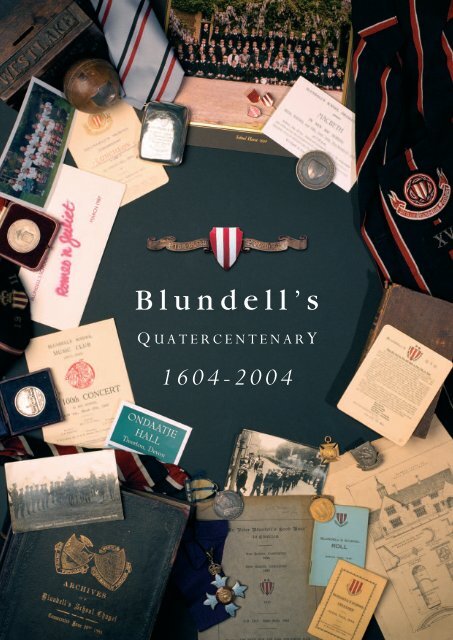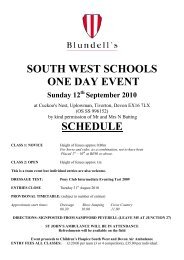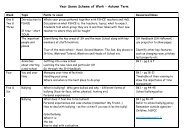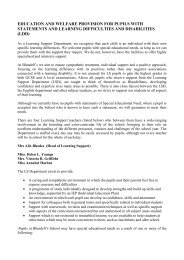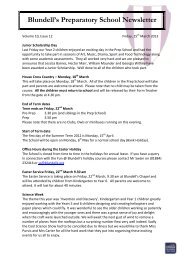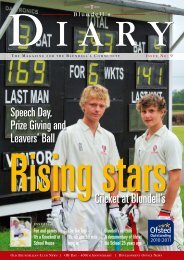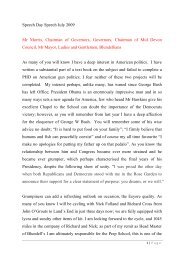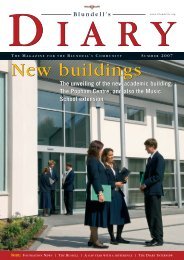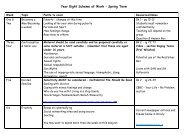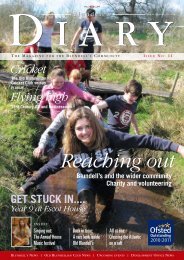1604-2004 - Blundell's School
1604-2004 - Blundell's School
1604-2004 - Blundell's School
You also want an ePaper? Increase the reach of your titles
YUMPU automatically turns print PDFs into web optimized ePapers that Google loves.
SELECTION POLICY FOR CANADIANTRACK CYCLING TEAM FOR THE XXX OLYMPIADNote: This policy document was written in English and translated to French. In case of any wording discrepancies between theEnglish and French versions of the selection policy, the English wording takes precedence.INTRODUCTIONThis Policy is in two parts. Part A sets out the background and procedure for selection of riders to all Canadian RoadPools and Teams. Part B sets out the general selection objective and criteria and Schedule 1 sets out the SpecificSelection Criteria for each gender and Event. Annex A is the International Cycling Union Olympic QualificationProcess.CCA BOARD OF DIRECTORS AND HIGH PERFORMANCE COMMITTEE APPROVED2012 Track Olympic selection policyAugust 2011 (Final Version)Page 1 of 12
“...thou I am not myself a scholar, I will be the meansof making more scholars than anyone else in England.”Attributed to Peter BlundellPeter Blundell, one of the wealthiest merchants of ElizabethanEngland, died in 1601, just before the great Queen, leaving money and landsto found a <strong>School</strong> in his home town to maintain sound learning and truereligion. No expense was to be spared in its construction. Generous landswere provided in Tiverton and South Devon for its maintenance andBlundell’s executors established links between the <strong>School</strong> and Balliol College,Oxford and Sidney Sussex College, Cambridge, which survive to this day.Blundell’s was to be a <strong>School</strong> much larger and grander than any other in theWest Country. Indeed, in the 1670s £600 was given to Balliol to found morescholarships, yet the running surplus in the Feoffees’ (Trustees) accounts wasstill over £500. From the beginning, under its first Headmasters the <strong>School</strong>flourished, producing clergy and gentry who took the lead in the Civil Warand the Glorious Rebellion in preserving the Protestant Religion and theliberties of the subjects, objects so dear to the heart of the founder. In anearly Eighteenth Century travel book the <strong>School</strong> was justly called ‘TheGreatest Glory of the Town’.
QUATERCENTENARY1 23 45 6789 10 1112131514 21161718 19 20Supporting these 400 years of service of the <strong>School</strong> to the nation has been thededicated contribution of Masters and Feoffees. One must remember in gratitude mensuch as Samuel Butler, the First Master, who laboured for 43 years, during which thePilgrim Fathers sailed for Massachusetts, and who retired as the Civil War ended.Master Rayner’s 32 years coincided with Marlborough’s victories and Walpole’s PrimeMinistership; William Richards’s reign included Trafalgar and Waterloo. Also there wasA.L. Francis, whose 43 year Headmastership started as the Franco-Prussian Warended, finishing as the battle of Passchendaele began. With them we remember thatcompany of men and, latterly, women who have given their working lives to theservice of this <strong>School</strong>.To start, oversee and continue his great work Peter Blundell appointed localmerchants and gentry as the first Feoffees. According to his will they were to behereditary and, as a father or uncle died, a son or nephew was appointed to the body.In modern times there have been reorganizations consonant with the march of time,but there have been Heathcoat Amorys on the Governing Body continuously for 150years and the first Fursdon to be a Feoffee was elected 250 years ago.The flow of scholars and clergy continued through the centuries. Numerous Hanoverianbishops, including George III’s tutor, culminated with Frederick Temple, theArchbishop of Canterbury who crowned Edward VII. The men of letters have rangedfrom Bampfylde Moore Carew who produced a ‘best selling’ account of his career as‘King of the Gypsies’ in the 1750s, through Richard Blackmore, who penned ‘LornaDoone’ a century later. John Squire (1901-2) knighted for his services to literature,and John Hollands (1946-1951) who wrote a novel of the Korean War which sold overa million copies in the 1950s. Through the mists of time we glimpse, among a host ofscientists, William Buckland (1797-98) the great geologist and A V Hill (1900-5) thewinner of a Nobel Prize for Biology. A Blundell’s Balliol Scholar, Thomas Davey, wasMaster of Balliol at a time when another Blundellian was Provost of Oriel, and a SidneyScholar, Knox Shaw (1900-1905) became Master of Sidney Sussex. The present Masterof Selwyn, Professor R.J. Bowring (Westlake 1960-1964), is also an Old Blundellian.1 Sir John Popham. 2 Frederick Temple(1834-39), Bishop of Exeter and Archbishopof Canterbury. 3 R.D. Blackmore (OB 1837-43), author of Lorna Doone. 4 BampfyldeMoore Carew ‘King of the Gypsies’. 5 Aninvitation to the Old Boy’s Feast of 1727. 6Lord Kitchener inspecting the Blundell’slines, Farnborough Camp 1910. 7 An early‘football’ team. 8 Cricket on the green, OldBlundell’s. 9 The Memorial Cross, a replica ofthe Cross of Eyam, dedicated 2 November1920. 10 The War Memorial 1939-45. 11Duckworth’s House in Bampton Street. 12The Reverend Jack Russell (OB 1809-14), thefamous ‘Hunting Parson’. 13 Blundell’s ownHome Guard. 14 The list of original Feoffees.15 Sander’s Prospectus, which advertised...‘every boy has a separate bed’. 16 A drawingby a school boy of the fold away beds. 17 OldBoys Day 1725. 18 An early 1840’s engraving, showing the end of the Master’sschoolroom. 19 The Common Room in 1886-87. The ‘heroic crew’ oversaw the move tothe new <strong>School</strong> site. 20 The Nobel Prize forphysiology and medicine awarded toProfessor A.V. Hill (OB 1900-1905). 21 The<strong>School</strong> Rooms at the end of the 18th century.Blundellians have been present at the great events of our history. There was aBlundellian, J H Hill (1792-6) at Waterloo, another, W Morris (1846-7) was at theCharge of the Light Brigade. Both were wounded. Blundellians were foremost in allparts of the Victorian Empire, and gave their lives in the Boer War and the two WorldWars. Every year sees numerous obituaries added to the <strong>School</strong> Archives of men whohave served their country well in the affairs of the 20th Century.At the gateway of all their lives was their time at Peter Blundell’s <strong>School</strong>. For thefirst 278 years this was in the ‘Old <strong>School</strong>’ by the Lowman, where the syllabus wasLatin and Greek and boys had to be tough to survive. Birches swished, older boystyrannized over younger, boarders told dayboys their place. Outside lessons life wasunsupervised. They hunted, they held cockfighting matches, they fished, they played asort of football and, after 1800, cricket (with 4 ball overs). It seems that they lovedit and cherished their school days by forming an Old Blundellian organization at leastas early as 1725. This has continued with two short gaps until today. Blundellians asdifferent as Parson Jack Russell and Archbishop Temple remembered those rough olddays with affection.4
QUATERCENTENARY22 2324 25272629 30283134323533363740443842394741 43 45 46In May 1882 the whole school moved up the road to its new home atHorsdon. Within ten years A L Francis had trebled numbers to 250, and <strong>School</strong>House, Old House, North Close, Petergate and Westlake had been built, so that asVictoria’s reign came to an end, Blundell’s had again taken its place among thecountry’s great schools, with high scholastic achievement and distinguishedperformance in those games, which the Victorians had developed to replace the rudesports of earlier centuries. In 1904 the Tercentenary was celebrated with due senseof pride. Not only had the boarding houses been built with funds put up by the firstboarding housemasters, but also Francis and his colleagues had paid for the additionalbuildings necessary for the growing numbers and the Chapel had been built entirelythrough voluntary subscription as a statement of faith in the future.During the last Century there has been continued great growth andchange. Under ‘Fusty’ Wynn (1917-30) numbers first topped 300 andFrancis House was built. Under Neville Gorton (1934-43) Blundell’sbecame a dynamo of educational novelty and, latterly, there has beenan explosion of activity. The continued support of the HeathcoatAmory family, with a long tradition of service on the GoverningBody, has been a key feature of the last century. Additionally, OldBlundellians via the Peter Blundell Society, and the singularmunificence of Sir Christopher Ondaatje (1947-51) have supportedmany developments over the last fifty years. Girls were admitted in1975, with full co-education starting in 1992, and they are now well overa third of over 550 Senior <strong>School</strong> pupils. St Aubyn’s Preparatory <strong>School</strong>has become an integral part of Blundell’s with almost 400 younger pupils.Soon there will be 1000 Blundellians! As ever throughout its long historythe <strong>School</strong> has occasion to be grateful to the support of those who haveadded to Peter Blundell’s initial generosity. ‘Great trees from goodlyacorns grow’!622 A.L. Francis’ ‘the Chief’. 23 Neville Gorton(1934-43) Bishop of Coventry. 24 DerickHeathcoat-Amory, Chancellor of theExchequer and Governor of Canada. 25Christopher Ondaatje (OB Petergate 1947-51). 26 A view of the new buildings takenabout 1900. 27 The Chapel as a building site.28 An early OH group. 29 The Junior House1912, outside the present GH. 30 Theunbeaten XI of 1889. Won 7 drawn 3. 31Chapel interior, the ornate pew ends wereremoved by Gorton. 32 The ‘Gill’ altar andoriginal cross. 33 The ‘Gill’ altar reinstated. 34The XI of 1945. The Captain, R.J. Morris,scored over 500 runs and took 43 wickets.Seated front left is E.R. Crowe (pupil FH 1943-46, Master 1953-89). 35 Francis Herring withthe <strong>School</strong> Orchestra of 1911. 36 The QueenMother opened the new buildings in 1967. 37The Tercentenary Invitation. 38 OB day 1912.39 The Tercentenary turnout of Old Boys. 40The first girl at Blundell’s, September 1975,Arabella Ashworth with Headmaster CliveGimson (1971-1981). 41 An artist’simpression of the new <strong>School</strong>. 42 Thewinners of the 1981 Rosslyn Park sevens. 43View of the War Memorial and Chapel 1923.44 Chapel and Clock Tower early 20thCentury. 45 Big <strong>School</strong> about 1910. Thepresent library. 46 The girls of NC, 2003. 47 StAubyn’s arrives at Blundell’s.As we set forth to march on Old Blundellian Day from Old Blundell’s toSt Peter’s to celebrate our 400 Years of History and begin our journey towards halfa millennium of continuous existence in 2104, wecarry with us echoes and memories of which weare proud and of which we can never bedeprived.
Blundell’s <strong>School</strong>TivertonDevonEX16 4DNTel: 01884 252543Fax: 01884 243232E-mail: registrars@blundells.orgwww.blundells.org


